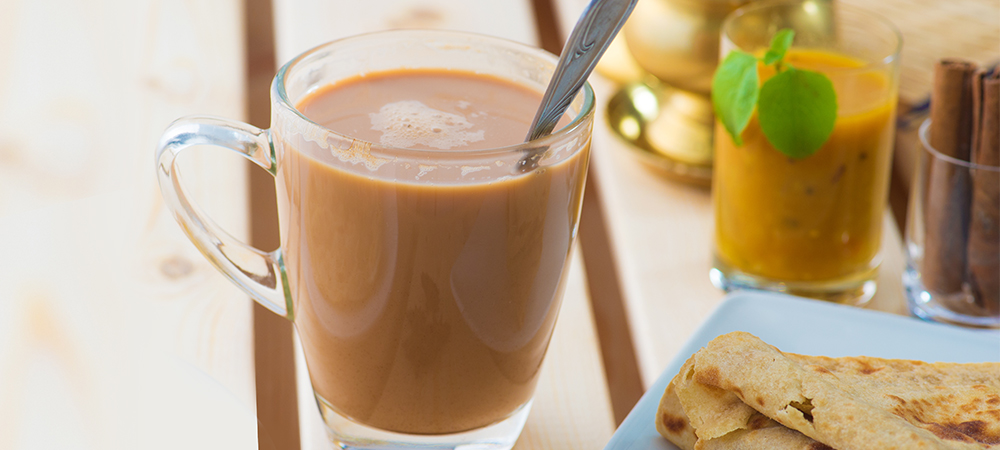On just about every street in Malaysia you’ll find a kopitiam, coffee shop, where citizens stop for meals, snacks and the national drink, teh tarik. Teh tarik (literally ‘tea pull’, but known as ‘pulled tea’) is a brew of strong black tea mixed with evaporated and condensed milk poured from a height to create a sweet, frothy liquid that is both fun to watch being made and hearty to drink.
[bctt tweet=”The ratio of tea to milk as well as evaporated to condensed milk is up to the tea maker.”]
My parents were both born in a small town called Taiping in the middle of peninsular Malaysia. Although their respective families were of Chinese heritage, both went to English schools. They knew of tea, of course—cheap Chinese brews from the markets, ‘milk with one’ in dainty teacups depicted in their English textbooks, and teh tarik—but tea was not a notable part of their upbringing.
By the time I was born, they worked as nurses in Sydney, Australia, and their brew of choice was instant coffee: Nescafe Blend 43. I still remember the day my dad considered me sufficiently old enough to make his afternoon cup. He had three sugars and enough milk that the liquor turned caramel-coloured.
We had tea in the house but hardly drank it; we offered it to guests who didn’t drink Nescafe. For a while it was a box of Bushells (Australia’s oldest tea company), then we had Dilmah teabags. Once, while trying to find something on the baking shelf, I discovered a red tin of loose leaf Chinese tea that had mistakenly been placed there decades prior. As far as I know, none of us have been brave enough to try the contents.
My formative tea experiences took place outside the house. I learnt to detest Chinese tea because of the horrible stuff served at Chinese restaurants, but my palate opened up to the exotic sweet frothiness of teh tarik on my first remembered trip to my parents’ homeland. I had been to Malaysia before, as a child, but it wasn’t until I was 12 that I learnt to embrace and appreciate the food and culture. The two things I took away from that visit were roti canai (layered flatbread and curry) and teh tarik.
Tea for tourists and locals alike
The basic recipe for teh tarik is a strong black tea made from tea dust. If you’re playing along at home, CTC Assam or a strong blend like Irish Breakfast is generally fine, though Malaysian brands made from local tea are specially formulated for teh tarik.
To the hot tea liquor, the tea maker adds a measure of milk, a mix of evaporated and condensed milk. When tea was introduced to Malaysia after World War II, the dairy industry was not well developed, so preserved milk had to suffice. It is now a necessary ingredient to replicate the historic taste.
The ratio of tea to milk as well as evaporated to condensed milk is up to the tea maker. While some complain that condensed milk makes the teh too sweet, it is essential to give the teh body and help produce long-lasting froth. The sweetness also counters any astringency in the tea.
The mix is then poured from one jug to another to produce froth and to cool the tea. The theatre of teh tarik is very appealing to tourists. For a couple of ringgit, you have a hot (or cold, though tourists should beware of consuming ice from street stalls) local beverage and a performance to boot. The most skilled teh tarik makers try to outdo each other in height and other pouring tricks, such that there are now competitions not just for the best-tasting teh tarik but also teh tarik performance.
[bctt tweet=”The basic recipe for teh tarik is a strong black tea made from tea dust.”]
Despite its tourist appeal, teh tarik is very much a drink for locals such that the Malaysian Government declared it part of the country’s beverage heritage. Ask where to get the best teh tarik and there are sure to be arguments as teh drinkers staunchly defend their favourite kopitiam.
After my first real taste of teh tarik, I was hooked. It accompanied just about every meal I ordered. We bought back packets of teh tarik mix and relatives who came to visit thereafter became teh tarik mules too. The mix, although not a patch on the real thing, sustained my interest in my parents’ home country. Even in Sydney today, I don’t consider a Malaysian restaurant a Malaysian restaurant unless teh tarik is on the menu.
Since then I’ve learnt a lot more about tea and have developed my palate for the Chinese brews I initially dismissed, but I still have a soft spot for the froth of teh tarik.


2 Comments
What wonderful memories I have of the time my family and I lived in Penang, Malaysia. I loved walking the streets of Georgetown. The air always smelled of all the different spices, chicken rice cooking at all the cafes, and satay on the grills. Watching the coffee house owners pull their tea was totally mesmerizing to me…..it was an art. Long streams of brown liquid pouring from one metal cup to another, usually at a distance of around 3 or more feet!
And it was so good!!!
I also will never forget visiting Cameron Highlands. We always stayed at the Smokehouse Inn, a very quaint British-style hotel with beautiful gardens. The Boh tea plantations were nearby. Their fields looked so manicured…rows and rows of lush, deep green tea bushes. They give a nice tour of their farms, showing you the full process of picking (by hand), drying, and packaging their tea.
Beautiful memories…Oh, Malaysia…how I miss you!
Pingback: Iced tea traditions from around the world - Tea Stories - Still Steeping: Teabox Blog